
You can use the apachelog level command to send errors to another program. There are three levels of warning: warning, debug and critical. Each level has its own advantages and disadvantages. The situation you are in will determine the level that is best for you. For example, if you are experiencing a server failure, you can set a high log level. For normal usage, you can set a low log level.
Log level modifications
Apache log levels can be modified to adjust the severity of log messages. The default level is warn. The other two levels, crit and emerg, are the default warning level. Warning logs can be generated when the system seems to be functioning normally but can develop into serious problems over time. You can debug your server by changing the log level.
Apache web servers generate logs. Changing the log level will have an effect on all logs. This will increase log file size and make the server work harder. To trace more detail, you can increase your log level.
Messages logged
If you have a server that uses Apache, you can analyze the messages logged in its error log to determine the cause of the error. This log includes information about what error occurred, when it occurred, and the severity level. It also contains information about client web browsers and operating systems.

Log files are created by Apache servers that store information provided by clients. These log files can be accessed with a simple text editor, such as tail or cat, which are command-line tools on Linux.
Messages logged with debug level
The debug level logs information about errors and warnings that occur in the application. These messages are useful for testing and debugging. Filtering the messages can be done by choosing the appropriate level. This allows you to get more information without losing any details. To gain more information on a particular subsystem or component, you can set the DEBUG/TRACE level. The INFO level should be used in production environments.
This level does not necessarily indicate that the application has stopped working. This is a sign that something is wrong with the application. Sometimes, the application might fail to access a file. Most applications can still be run normally and will not display an error message.
Messages logged with FATAL level
A message logged with FATAL level designates a very serious error, such as a database corruption, a major problem, or a complete application failure. These errors must be rectified immediately to avoid financial and data loss. This doesn't necessarily mean that programs have failed. Most applications will continue to run despite these events.
The severity levels are ranked in order of severity. If the error message contains the word FATAL, it will cause the program to terminate and log the error. If the error is less severe, the log message is logged in lower severity logs. If the message has a DFATAL level, it will be logged in debug mode instead of production. This is to prevent the program being stopped in a living system.

TransferLog level logs messages
There are three levels for log messages: "emerg", unusable, and alert. An "emerg” message signifies that the system is malfunctioning and must be fixed immediately. The "warn" message should not be ignored and should be reported for further investigation. "Info" messages are useful for troubleshooting purposes, and "debug" messages contain more detailed information.
Apache also records the status or connection of HTTP requests. The HTTP status code can be used to measure the website's speed. A 404 response, for example, includes Referer information.
FAQ
Do I hire a web developer or make it myself?
If you are looking to save money, don't spend on web design services. It may not be a wise decision to pay for web design services if you desire high-quality results.
You can build websites yourself without paying for professional designers.
If you're willing and able to invest the time and effort to create a stunning website, you can use free tools such as Dreamweaver or Photoshop to learn how to do it yourself.
Another option is to hire a freelance web developer for a project that charges per hour.
What HTML and CSS are available to help me build my website?
Yes! You should be able to create a website if you have been following the instructions.
You're now familiar with the basics of creating a website structure. However, you must also learn HTML and CSS Coding.
HTML stands to represent HyperText Markup Language. It is similar to writing a recipe. You'd list the ingredients, instructions, along with directions. HTML is a way to tell a computer which parts are bold, underlined, italicized or linked to other parts of the document. It is the language of documents.
CSS stands as Cascading Stylesheets. It is like a stylesheet that you use to create recipes. Instead of listing each ingredient and instructing, you can write down general guidelines for font sizes, colors and spacing.
HTML tells a browser how to format a webpage; CSS tells a browser how to do it.
Don't panic if either of these terms are confusing to you. Follow these steps to make beautiful websites.
What is a website static?
A static website is possible to be hosted anywhere: Amazon S3, Google Cloud Storage or Windows Azure Blob storage. Rackspace Cloudfiles, Rackspace Cloud Files. Dreamhost and Media Temple. You can also deploy static sites to any platform that uses PHP, such WordPress, Drupal Joomla! Magento PrestaShop.
Static web pages are usually easier to maintain because they're not constantly sending requests back and forth between servers. A static web page loads faster as there is no need to forward requests back and forth among servers. For these reasons, static web pages are often better for smaller companies that don't have the time or resources to manage a website properly.
What Should I Include In My Portfolio?
Your portfolio should consist of all these things:
-
Some examples of your past work.
-
If possible, links to your site
-
Link to your blog.
-
These are links to social media sites.
-
Here are links to portfolios online of other designers.
-
Any awards that you have received.
-
References.
-
Examples of your work.
-
These are links showing you how to communicate effectively with clients.
-
These links show that you are open to learning new technologies.
-
These are links that show your flexibility
-
These links show your personality.
-
Videos showing your skills.
What is the cost of creating an ecommerce website?
It all depends on what platform you have and whether or not you hire a freelancer. eCommerce websites start at about $1,000.
Once you've chosen a platform you can expect to pay $500-$10,000.
You won't spend more than $5,000 if you are using a template. This includes any customization you need to make to fit your brand.
WordPress: Is it a CMS or not?
The answer is yes. It is a Content Management System (CMS). CMS allows you control your website content using a web browser and not an application like Dreamweaver, Frontpage or Frontpage.
The best part about WordPress is that it's free! Hosting, which is usually provided by your ISP, is free.
WordPress was originally created to be a blogging platform. But WordPress now offers many more options, such as eCommerce sites or forums, membership websites and portfolios.
WordPress is easy to install and set up. The installation file must be downloaded from the website and uploaded to your server. Then, you simply visit your domain name through your web browser and log in to your new site.
After installing WordPress, register for a username/password. Once you log in, you will be able to access your settings from a dashboard.
From this page, you can add images, pages, posts, menus or widgets to your website. You may skip this step if you feel comfortable editing and creating content.
You can also hire a professional web design firm to help you with the whole process.
Statistics
- Is your web design optimized for mobile? Over 50% of internet users browse websites using a mobile device. (wix.com)
- Studies show that 77% of satisfied customers will recommend your business or service to a friend after having a positive experience. (wix.com)
- At this point, it's important to note that just because a web trend is current, it doesn't mean it's necessarily right for you.48% of people cite design as the most important factor of a website, (websitebuilderexpert.com)
- When choosing your website color scheme, a general rule is to limit yourself to three shades: one primary color (60% of the mix), one secondary color (30%), and one accent color (10%). (wix.com)
- The average website user will read about 20% of the text on any given page, so it's crucial to entice them with an appropriate vibe. (websitebuilderexpert.com)
External Links
How To
How can I start as a UI Designer
There are two routes to becoming a UI Designer:
-
You can earn a degree in UI Design by going to school.
-
It is possible to start a freelance career.
For you to be able to finish school, you must attend college or university. This includes art, computer science, business, marketing, psychology, etc.
There are also state universities and community colleges that offer classes. Some schools offer programs for free, while others require tuition fees.
You will need to find work after graduation. If you decide to work for yourself, it is important that you build your client base. It is essential to establish a professional network so other professionals know you exist.
Opportunities to intern in web development companies are available. Many companies hire interns to gain experience before hiring full-time employees.
It will be easier to land more jobs once you have a portfolio of your work. You should have work samples and information about the projects you worked on in your portfolio.
It's a smart idea for you to send your portfolio by email to potential employers.
Freelancers need to promote themselves. You can also advertise your services via job boards like Guru, Indeed, Guru, Upwork, and Freelance.
Freelancers are often assigned by recruiters posting job openings online. These recruiters search for qualified candidates to fill positions within specific industries.
These recruiters typically provide the candidate with a project brief outlining the position's requirements.
As a freelancer, you are not required to sign any long-term contracts. If you are looking to make a move, however, it is advisable to negotiate an upfront payment.
Many designers prefer working directly for clients and not through agencies. While this may seem ideal, many people lack the necessary skills.
Agency workers often have extensive industry knowledge. They have access to resources and training that enable them to produce high quality work.
Agency workers often receive higher hourly rates in addition to these benefits.
You won't be able to get in touch with your employer directly if you work with an agency.
As a UI designer you need to be motivated, creative, flexible, detail-oriented and communicative.
You must also possess excellent verbal and written communication skills.
UI designers create user interfaces and visual elements for websites.
They are also responsible to ensure the site meets user needs.
This includes understanding the information that visitors require and how the site should function.
To create wireframes, UI designers can use a variety of tools. They use wireframing to help them visualize the layout of a webpage before they start designing.
You can find wireframe templates online. This makes it easy to make your own wireframes.
Some designers are solely focused on UI design while others blend UI design and graphic design.
Photoshop is used to edit images by graphic designers.
To create pages and layouts, they then use Adobe InDesign.
Photographers capture images using digital cameras or DSLRs.
The photos are then uploaded to a photo editing software where text captions, filters and other effects can be added.
The photographer saves the image as a compatible file format for the website.
It is crucial to consider all aspects when designing a website.
This includes research and planning, wireframing, prototyping testing, coding, content creation and publishing.
Research – It is essential to do extensive research before you begin a new project.
Planning – Once you've done your research, you will want to start developing a plan.
Wireframing is a preliminary sketch for a web page, or application.
Prototyping - Prototypes help ensure that the final product matches the initial vision.
Testing – The prototype should go through multiple rounds to be tested in order for it to work properly.
Coding - Coding is the act of writing computer code.
Content Creation – This covers everything from creating copy to managing social accounts.
Publishing involves uploading files to a server, and making sure the site is accessible.
You'll need to be able to understand the different projects you work on as a freelance UX/UI Designer.
Some companies, for example, only need wire frames. Others require complete prototypes.
Depending on the type of project you accept, you may be asked to complete specific tasks.
You might, for example, be asked to create multiple wireframes if you're being hired to do wireframe design.
You may need to develop a functional version of the site if you are hired to build a prototype.
It doesn't matter what kind of project it is, strong interpersonal skills are essential.
Since most clients hire freelancers based on referrals, you must build solid relationships with potential employers.
In addition, you must be able to communicate effectively both verbally and in writing.
A portfolio is an important tool in any freelancer's arsenal.
It displays your work and shows your ability to produce high-quality results.
This is possible by creating an online portfolio.
It is a good idea to look for websites that are similar to yours to get you started.
You can then search these websites to find out which one offers its services.
Once you have identified the best practices you believe are most effective, you can start to implement them.
It's also useful to include links from your portfolio in your resume.